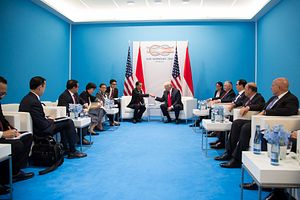Last week, a high-ranking U.S. defense official visited Indonesia. The visit highlighted some of the ongoing efforts by both sides to continue to boost U.S.-Indonesia defense relations, including on specific deals such as on aircraft.
As I have noted before in these pages, the United States and Indonesia share a defense relationship that has included components such as visits, exchanges, regular exercises, and defense sales. Both sides have continued to develop the defense aspect of the relationship into 2019 amid wider developments, including the commemoration of the 70th anniversary of the establishment of their diplomatic relations and the transition to Indonesian President Joko “Jokowi” Widodo’s second term following his election victory earlier this year.
Last week, the defense aspect of the relationship was in the headlines again with the Indonesia visit of Christopher Johnston, the U.S. acting deputy assistant secretary of defense for South and Southeast Asia. The visit constituted Johnston’s first to Indonesia since his assumption of the position.
During the visit, Johnston met with a range of Indonesian officials, including the defense ministry’s secretary general Agus Setiadji on October 22. The meeting between Johnston and Setiadji, which occurred at the office of the Indonesian defense ministry, touched on various issues tied to the state of the overall bilateral defense relationship.
One of the issues that was discussed during the meeting was the Lockheed Martin C-130J Hercules transport aircraft. Per Indonesia’s defense ministry in a press release on the meeting, the two sides discussed procurement of the aircraft as well as prospects for industrial cooperation related to it as well.
The discussion about the aircraft is in keeping with previous developments in the bilateral relationship. Indonesia has been eyeing the C-130J Hercules as an option for adding to the capabilities of the Indonesian Air Force, in part due to the service’s aging aircraft, including older C-130 aircraft some of which date back to the 1960s. And Indonesian officials, including former Defense Minister Ryamizard Ryacudu, had said previously that Indonesia was looking at an initial procurement of five aircraft, with follow on orders possible in the future as well.
Unsurprisingly, not much was publicly disclosed in terms of additional details about the private discussions, including the number of platforms Indonesia intends to purchase or specific incremental timelines. The defense ministry press release only noted that Indonesia had hoped that Washington could help accelerate the process of procurement, and that there could possibly be more meetings or talks on defense collaboration including this issue. Nonetheless, this aspect of the bilateral defense relationship will continue to be important to watch as one among many tangible aspects of ongoing collaboration.
































